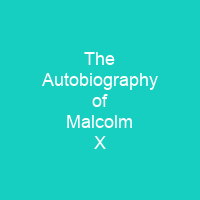The Autobiography of Malcolm X: A Journey Through History
Imagine a journey through the tumultuous life of one of America’s most influential figures, captured in the pages of The Autobiography of Malcolm X. This powerful narrative, written by Malcolm X and journalist Alex Haley, offers more than just a recounting of events; it is a profound exploration of identity, struggle, and transformation. How did this collaboration between two men shape one of the most significant autobiographies in American literature?
The Collaboration Between Malcolm X and Alex Haley
Malcolm X and Alex Haley embarked on an extraordinary journey to craft The Autobiography of Malcolm X. Their partnership was marked by a blend of editorial oversight, personal insight, and mutual respect. Haley’s role as both interviewer and editor was crucial in shaping the narrative, yet he always deferred to Malcolm X’s specific choices when it came to the final manuscript.
How did Haley influence the book? He guided Malcolm X in critical stylistic and rhetorical decisions, ensuring that the text resonated with a broader audience. His discretion over content and his ability to build suspense and drama were pivotal in crafting a compelling narrative. Yet, despite these interventions, the final product remained true to Malcolm X’s voice and vision.
Authorial Agency and Editorial Influence
Rhetorical questions arise: Who truly wrote The Autobiography of Malcolm X? Was it solely Malcolm X, or did Alex Haley play a significant role? Scholars like Marable argue that the collaboration was more than just an ‘as told to’ account. Haley’s contributions were essential in recovering the historical identity of Malcolm X and shaping the narrative.
Stone and Dyson emphasize the cooperative nature of their partnership, highlighting how both men contributed to the final product. Haley’s role as a spiritual confessor and stylistic guide was crucial, but he also deferred to Malcolm X’s specific choices when it came to the manuscript. This dynamic created a unique blend of voices that enriched the narrative.
The Impact on American Culture
How did The Autobiography of Malcolm X impact American culture? The book has had a profound influence, inspiring generations of readers and shaping the Black Arts Movement. It has been credited with influencing writers like Amiri Baraka, bell hooks, and David Bradley to explore themes of oppression, revolution, and social justice.
The Autobiography’s enduring legacy is evident in its continued relevance and popularity. Since its initial publication, it has sold millions of copies and returned to bestseller lists multiple times. Its impact extends beyond the literary world, influencing political movements and societal discourse.
Conclusion: The Myth and Reality of Malcolm X
The Autobiography of Malcolm X is a testament to the power of collaboration and the complexity of autobiography. It invites us to question who writes our stories and how these narratives shape our understanding of history. As we continue to explore this iconic work, let us remember that it is both a myth and a reality—a powerful blend of personal experience and literary artistry.

You want to know more about The Autobiography of Malcolm X?
This page is based on the article The Autobiography of Malcolm X published in Wikipedia (retrieved on November 30, 2024) and was automatically summarized using artificial intelligence.







